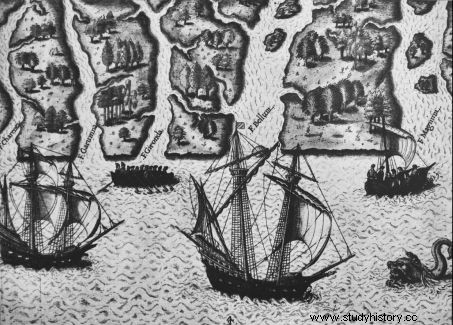A 16th century wreck, found in 2016 not far from Orlando, has been recognized as property of France by the American justice system. She would belong to the fleet of the explorer Jean Ribault, who left to establish a colony in Florida between 1562 and 1565.

15th-16th century fleur-de-lis cannon found on the wreck of the "Trinity", off the coast of Florida.
After two years of litigation, the American justice has delivered its verdict:the 16th century wreck found off the coast of Florida (United States), in 2016, by the private company Global Marine Exploration inc. (GME), does indeed belong to France. It is by these conclusions that Judge Karla Spaulding ruled, at the Court of Orlando (Florida), on June 29, 2018, as recently reported by the New York Times . Evidence of this parentage? The royal coat of arms present on three bronze cannons and a very rare "beaconing stone" adorned with fleur-de-lis, discovered by treasure hunters at the bottom of the ocean. These pillars were intended to mark the new territorial possessions.
Certain to deal with the remains of La Trinité and Esmérillon , the ships of the fleet of Jean Ribault (or Ribaut) and Vincent Colas, sunk in 1565, the Division of Maritime Affairs and Law of the Sea had as early as 2016, alerted by the Drassm, claimed ownership of the wreck in the name from France. "On one of the barrels was still the initial of one of the founders of François 1 er , and on a second, the coat of arms of Henri II “said Michel L’Hour, director of the Department of Underwater and Underwater Archaeological Research (Drassm).
"Since the passage of the Sunken Military Act by the United States on October 28, 2004, nations have sovereignty over their former warships found in United States territorial waters “, explained to Sciences et Avenir, the archaeologist.
Ships from the fleet of Jean Ribault, in the 16th century. Credits:Jacques Le Moyne de Morgues
In 1562, -more than 200 years before the creation of the United States-, but also at the dawn of the first War of Religion (1562-1563), the navigator from Dieppe Jean Ribault, had been sent by Admiral de Coligny (1519-1572) found French Florida. And so Charlesfort, then Fort Caroline.
Portrait of Admiral Gaspard de Coligny (1519-1572), anonymous painting from the 16th century, Musée du protestantisme, Paris. Credits:AFP photo
But in 1565, on his return from a second trip where he had come to reinforce the colony, which was in the grip of serious difficulties - mutinies, famines, wars with the Indians - the maritime expedition had turned into a disaster. Caught in a tropical storm, the building had not resisted and had sunk eight meters deep... where it is still. Alas, the misfortune was not going to stop there. Survivors, the French captain and his men had managed to reach the coast, thinking they could take refuge in Fort Caroline. But there, the Spanish troops of Admiral Pedro Menendez des Avilés, Captain General of the Indian Fleet, were waiting for them… All were going to be executed “not as Frenchmen, but as Huguenots », -by skinning them alive, decapitating or dismembering them-, according to the leyenda negra , the black legend. The soldiers of Admiral Gaspard de Coligny and most of the members of the French colony were thus massacred, whom the Spain of Philip II did not want to see gain a foothold in what they considered to be their sphere of influence in America. (read box ). Only about fifty Catholics, women and children would have been spared. And it was on the ruins of this French settlement that they razed, that in 1565, the Spaniards built St Augustine, the oldest city erected by Europeans in North America.
What follow-up will be given to this finding? For the time being, the French authorities wish to wait until August, and the end of the appeal period to decide. Indeed, after the decision of the Court of Florida, Robert Pritchett, the director of GME considered that the French had no means of proving that it was Jean Ribault's ship... According to him, once the explorer executed, the fleur-de-lysed guns had been loaded onto a Spanish ship. The Florida wreck would therefore not be French. Attempt at storytelling which does not seem to have moved the American magistrate in the least. John de Bry, director of the Center for Historical Archeology at Melbourne Beach, west of Orlando, Florida, delighted with the findings, said it was "the most major shipwreck never discovered in North America ". Since France has cooperation agreements with the United States, a scientific study of this major site could later be carried out by bringing together researchers from both countries.
Capture of Florida by Jean Ribault in 1562. Credits:Jacques Le Moyne de Morgues
The French adventure of the Huguenots in America, and the Colony of Fort Caroline.
In the same way that he had already attempted it from 1555 to 1560, in Brazil, with Nicolas Durand de Villegagnon and the ephemeral colony of Guanabara Bay, in Rio, for Antarctic France; in 1562, Admiral Gaspard de Coligny, leader of the French Protestants, asked Jean Ribault to establish a Huguenot colony in Florida. Leaving with René de Laudonnière and the cartographer and illustrator Jacques Le Moyne de Morgues, the expedition attempted to take possession of French Florida by creating Fort Caroline. But this attempt at colonization proved to be a failure, and ended in a bloodbath. After the massacre of the Lutherans by the Spaniards, punitive operations came to make the Spaniards suffer the same fate. “The true heirs of French Florida were the English. Careful observation of the French experience was later to serve as a lesson for the establishment of the colony of Virginia in 1585 wrote historian Hélène Lhoumeau in “The French expeditions to Florida (1562-1568 )".
Find out more :"The French Expeditions to Florida (1562-1568) », by Hélène Lhoumeau, Thesis of the Ecole des Chartes, 2000.



